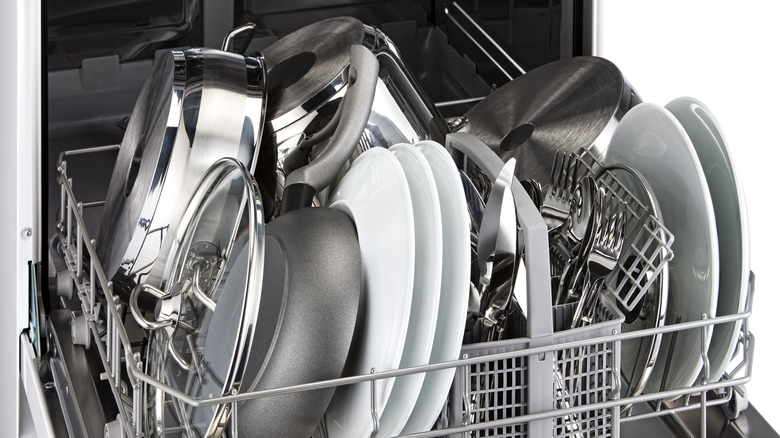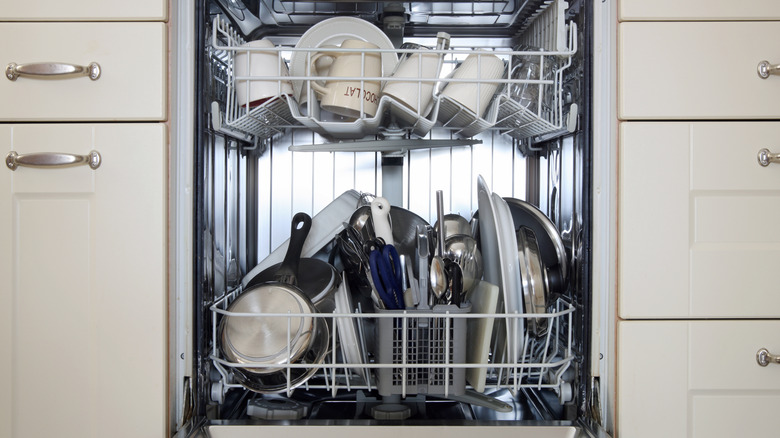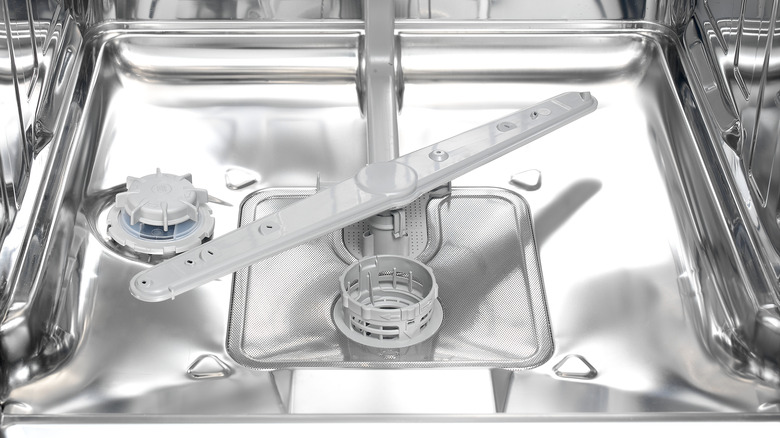How To Position Pans In The Dishwasher Without Blocking The Jets
While humans can agree on many things, everyone loads their dishwasher differently. Some like to put bowls on the top rack, instead of the bottom. Others pack knives into the silverware basket sharp-side up, which some believe is a dangerous placement, though others argue cleans them better. And some people load their pots and pans into the machine while others prefer to wash by hand.
There are several tips when it comes to the best way to load your dishwasher so that you get the cleanest dishes, pots, and pans possible. But one thing you some may not always consider is the position of the water jets and ensuring they're not blocked.
When you turn your dishwasher on, a basin at the bottom fills with water, which is then heated and mixed with detergent. The soapy water mix is then propelled through the jets via a rotating spray arm typically below the bottom rack. (Some models also have a spray arm below or above the upper rack). The water forced from these jets is what helps clean your dishes, which is why their position is so important. Without loading your dishwasher properly, paying special focus to bulky pans that could block the jets, your dishes might not come out as clean as you'd like.
It's best to angle pans on the bottom rack
When you have a large amount of dishes to be cleaned, including bulky pans, large dining plates, and baking dishes, the best practice is to always put items that take up the most space on the bottom rack. As well, you'll want to load pans and baking dishes at an angle between the rack's tines, rather than laying them flat. This way, these larger items won't block the jets and won't prevent water and soap from reaching items on the top rack.
If your pans have room to stand upright in between the bottom rack's tines, you should also face them toward the center of the dishwasher, where the jets are usually located on the spray arm. This will give them the most direct access to water and detergent and ensure that all the remaining food particles are blasted off.
Also, it's a good idea to leave some room for the bottom rack dishes to breathe. It can be tempting to load every last dirty pan and dish around the house into the dishwasher at the end of the night, but when they're stacked this tightly against each other, the jet spray can't reach in between everything. In this case, it might be good to space things out and run through two separate cycles if needed.
Don't forget to clean the jets from time to time
Even if your pans are perfectly positioned in the dishwasher, the jets still might be blocked if there's any food residue that builds up on the arms; if this is the case, they will be unable to do their best work. If you find that you're taking dishes and pans out of the machine and they are still dirty, don't forget some simple dishwasher maintenance tasks. It might seem counterintuitive to clean an appliance that cleans for you, but a little bit of upkeep goes a long way in preserving the effectiveness and longevity of your dishwasher, and will better ensure your pans are fully clean when you take them out.
Along with regularly wiping down your dishwasher's filters and seals, don't forget to take a damp cloth to the spray arm and its jets once a month. And, every six months or so, you should remove the spray arm completely for a deeper clean. You can soak it in a hot water bath with soap and vinegar to break down any gunk that might be stuck on the surface. For extra deep-cleaning, insert a toothpick or pin into each individual jet on the spray arm to remove any blockages inside. You can also run a used lemon through the dishwasher for some extra cleaning strength, too.



